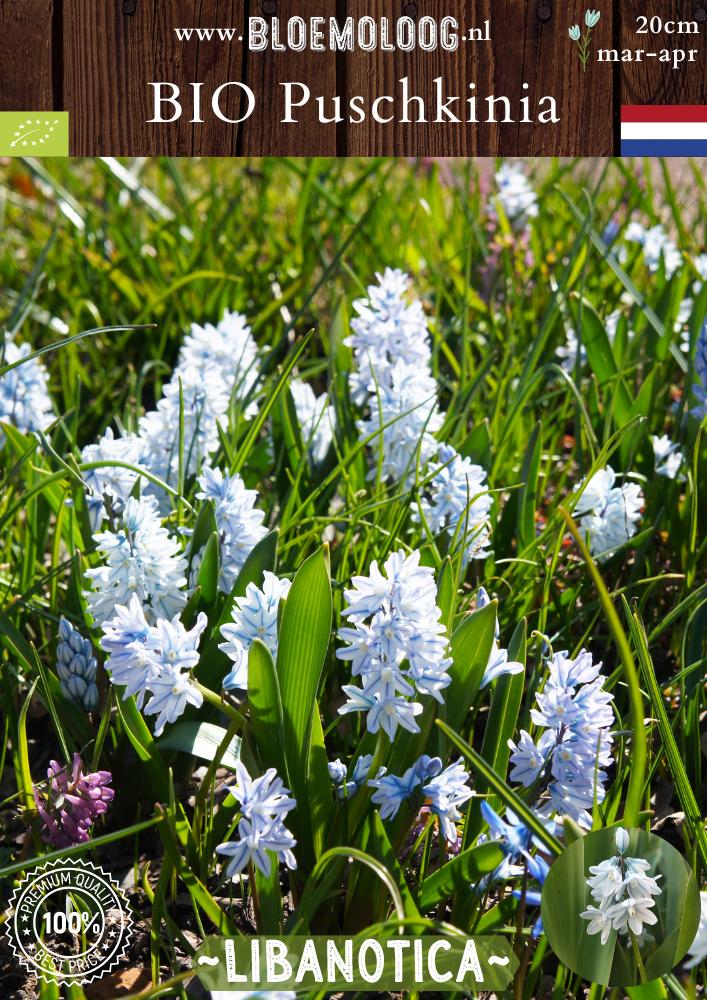Bloemoloog
Organic Puschkinia 'Libanotica' - Russian snowdrops | 10 pcs.
Organic Puschkinia 'Libanotica' - Russian snowdrops | 10 pcs.
Estimated Shipping Widget will be displayed here!
Couldn't load pickup availability
Organic Russian Snowdrops
The Puschkinia 'Libanotica' is a beautiful naturalizer that is also known as 'Russian snowdrops' or 'striped aquills'. It blooms with bunches of star-shaped flowers on a flower stem of 20 cm high. The flowers are white with a baby blue stripe through the center of the petals. It produces approximately 15 to 40 flowers per flower stem. It has broad leaves that are about as high as the flowers during flowering.
The versatility of the Puschkinia 'Libanotica' is impressive. Whether you want to brighten up pots, transform your garden or create a vibrant carpet of flowers in your lawn, this hardy bulbous plant thrives in almost all soil types and will reliably return to grace your garden year after year.
How, where and when do I plant tube hyacinth flowerbulbs?
Plant the flowerbulbs in the autumn, preferably between September and December. This gives the bulbs enough time to root before winter arrives and ensures beautiful blooms in spring. Choose a location in the garden that is sunny to partly shaded. Tubular hyacinths thrive in both full sun and light shade.
Dig up the soil and remove any weeds, rocks or other contaminants. Tubular hyacinths prefer well-drained soil such as loam or sandy soil. You can improve the soil by adding compost or organic matter to improve drainage and provide nutrients. Dig a planting hole that is about 5-7 centimeters deep. Place the flowerbulbs in the planting hole with the pointed side up. Keep a distance of about 5-8 centimeters between each flowerbulb, this will give the bulbs enough room to grow and multiply. Place the flowerbulbs evenly distributed in the planting hole. Cover them with soil and press gently to firm the soil around the bulbs.
Care of the Puschkinia
Russian snowdrops have moderate water needs. Give them some water during a very dry period. Make sure the soil is evenly moist, but avoid waterlogging as this can damage the bulbs. In general, tube hyacinths do not require special fertilizer, but if the soil is poor, you can give a light application of a balanced fertilizer during the growing season.
We recommend Bio Kultura for organic potting soil, plant food and other soil improvers!
After flowering, you can remove the spent flowers to focus the plant's energy on strengthening the bulbs. However, leave the foliage alone until it has completely yellowed and wilted as this will help nourish the bulbs for the next season.
Propagation
Tubular hyacinths reproduce by forming new bulbs. To rejuvenate the plant and prevent them from growing too close together, you can dig up and tear the bulbs every few years in the fall. Replant the individual bulbs at the desired distance.
Origin of the Puschkinia
The origin of Puschkinia 'Libanotica' lies in the eastern Mediterranean, mainly in Lebanon and Turkey. This region is considered the natural range of the 'Libanotica'. The name 'Libanotica' in the botanical name refers specifically to the region of Lebanon.
It is a bulbous plant that grows wild in mountainous areas and open grasslands. Because of its attractive flowers and ability to naturalize, this bulbous plant has become popular in gardens around the world.
Buy Organic Puschkinia 'Libanotica'
Skal NL-BIO-01 certified: 109459
Packed per 10 flower bulbs or choose a stacking discount.
Stacking discount: E
Can be ordered from June '25!
EU shipping €8.95 - Free shipping from €100 purchase.
Characteristics
| Flowering time: | March - April |
| Planting time: | From September |
| Planting depth: | 7 cm deep |
| Planting distance: | 7 cm apart |
| Height: | 20 cm high |
| Flower diameter: | 10 cm wide |
| Location: | Partial shade, sun |
| Soil PH: | Loam, sandy soil - Slightly acidic/neutral |
| Winter hardiness: | Good hardy |
| Propagation: | Good (naturalizes) |
| Origin: | Turkey and surroundings |
| Family: | Hyacinthaceae (hyacinth family) |
| Colour: | Blue White |
| Bee-friendly: | Yes |
| Fragrant: | Yes |
| Bulb size: | 5+ |

NL-BIO-01
To share




